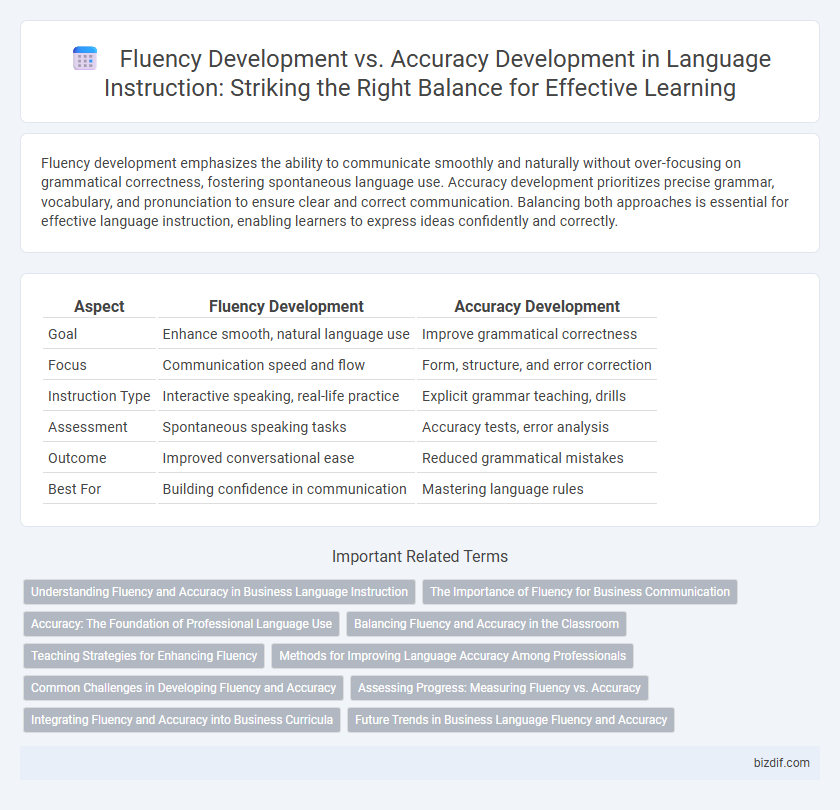Fluency development emphasizes the ability to communicate smoothly and naturally without over-focusing on grammatical correctness, fostering spontaneous language use. Accuracy development prioritizes precise grammar, vocabulary, and pronunciation to ensure clear and correct communication. Balancing both approaches is essential for effective language instruction, enabling learners to express ideas confidently and correctly.
Table of Comparison
| Aspect | Fluency Development | Accuracy Development |
|---|---|---|
| Goal | Enhance smooth, natural language use | Improve grammatical correctness |
| Focus | Communication speed and flow | Form, structure, and error correction |
| Instruction Type | Interactive speaking, real-life practice | Explicit grammar teaching, drills |
| Assessment | Spontaneous speaking tasks | Accuracy tests, error analysis |
| Outcome | Improved conversational ease | Reduced grammatical mistakes |
| Best For | Building confidence in communication | Mastering language rules |
Understanding Fluency and Accuracy in Business Language Instruction
Fluency development emphasizes the ability to communicate smoothly and efficiently in business contexts, prioritizing quick thinking and natural language flow over perfect grammatical accuracy. Accuracy development focuses on mastering precise language rules, terminology, and proper syntax to ensure clear and professional communication in business settings. Effective business language instruction balances both fluency and accuracy to equip learners with the skills needed for confident, error-free interactions.
The Importance of Fluency for Business Communication
Fluency development is crucial for effective business communication, enabling professionals to convey ideas smoothly and confidently without excessive hesitation. Prioritizing fluency allows for quicker decision-making and fosters dynamic interactions in meetings, negotiations, and presentations. Enhancing fluency contributes to building stronger relationships and improving overall workplace productivity by minimizing misunderstandings.
Accuracy: The Foundation of Professional Language Use
Accuracy development forms the foundation of professional language use by ensuring precise grammar, vocabulary, and pronunciation necessary for clear communication. Mastery of accuracy reduces misunderstandings and builds credibility in professional settings, which is critical for effective interaction and written correspondence. Prioritizing accuracy early in language instruction creates a solid base for achieving fluency without sacrificing correctness.
Balancing Fluency and Accuracy in the Classroom
Balancing fluency and accuracy development in language instruction requires integrating activities that promote spontaneous communication alongside targeted practice of grammatical structures. Emphasizing fluency through conversational exercises enhances learners' confidence and natural language use, while accuracy-focused activities help solidify correct language forms and reduce errors. Designing classroom tasks that alternate between these focuses ensures that students develop both the ability to express ideas fluidly and the precision needed for effective communication.
Teaching Strategies for Enhancing Fluency
Teaching strategies for enhancing fluency prioritize natural communication through activities like timed speaking tasks, role-plays, and extensive reading, which encourage automatic language use without overemphasizing error correction. Techniques such as repeated reading and shadowing improve speed and intonation, helping learners internalize language patterns for smoother speech production. Emphasizing fluency aids learners in developing confidence and communicative competence by fostering real-time language processing rather than focusing solely on grammatical precision.
Methods for Improving Language Accuracy Among Professionals
Methods for improving language accuracy among professionals include targeted grammar exercises, error correction techniques, and repetitive practice focused on common linguistic challenges in professional settings. Using authentic materials such as business documents and real-life communication scenarios enhances contextual understanding and precision. Incorporating feedback mechanisms, like peer review and instructor-led corrections, solidifies accurate language use while balancing fluency development.
Common Challenges in Developing Fluency and Accuracy
Balancing fluency development and accuracy development presents common challenges such as learners prioritizing speed over correctness, leading to fossilized errors. Many language students struggle to self-correct in real-time, which hinders accuracy improvement while striving for conversational flow. Effective instruction requires targeted practice that integrates automatic language use with focused error correction to enhance both fluency and accuracy simultaneously.
Assessing Progress: Measuring Fluency vs. Accuracy
Measuring fluency progress involves assessing a learner's ability to communicate smoothly and naturally, emphasizing speed, rhythm, and confidence in language use. Accuracy development measurement focuses on the correctness of grammar, vocabulary, and pronunciation, highlighting error-free production. Effective language instruction balances both metrics by employing tools such as timed speaking tasks for fluency and error analysis in written assessments for accuracy to provide a comprehensive view of learner progress.
Integrating Fluency and Accuracy into Business Curricula
Integrating fluency and accuracy development into business curricula enhances communication effectiveness by balancing spontaneous speaking skills with precise language use. Emphasizing authentic business scenarios facilitates fluency, while targeted grammar and vocabulary exercises improve accuracy critical for professional contexts. Curriculum design that combines role-plays, presentations, and error correction supports comprehensive language competency for business learners.
Future Trends in Business Language Fluency and Accuracy
Future trends in business language instruction emphasize balancing fluency development with accuracy to meet evolving global communication demands. Advanced AI-driven platforms prioritize adaptive learning paths that enhance conversational fluency while reinforcing grammatical precision. This dual focus supports professionals in achieving effective and error-free communication across diverse international markets.
Fluency development vs Accuracy development Infographic

 bizdif.com
bizdif.com